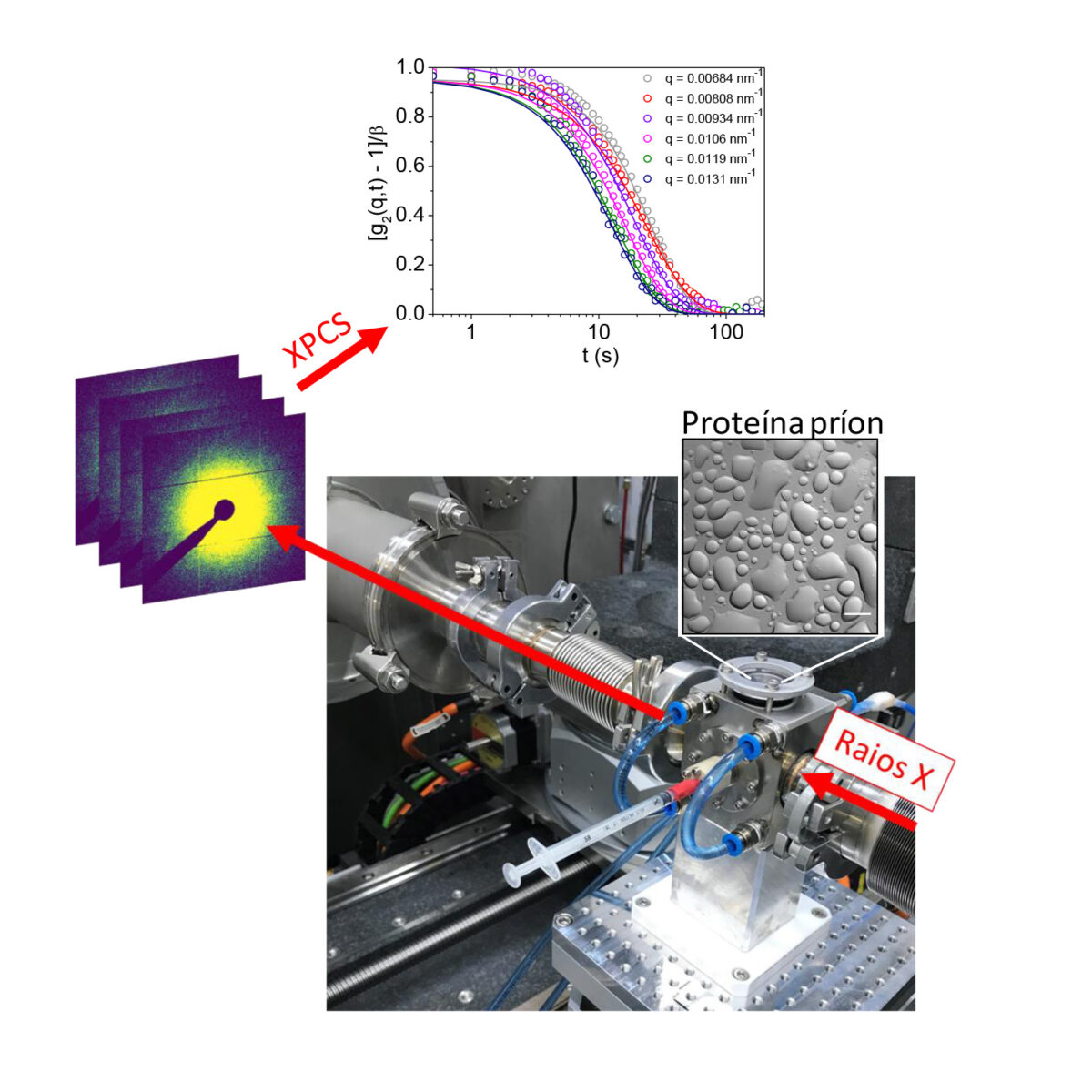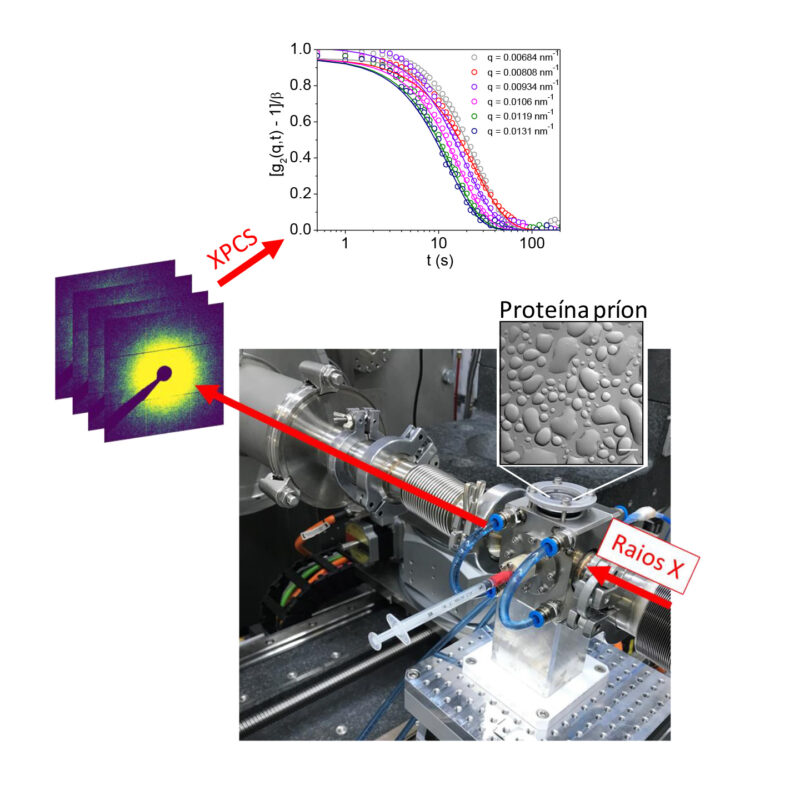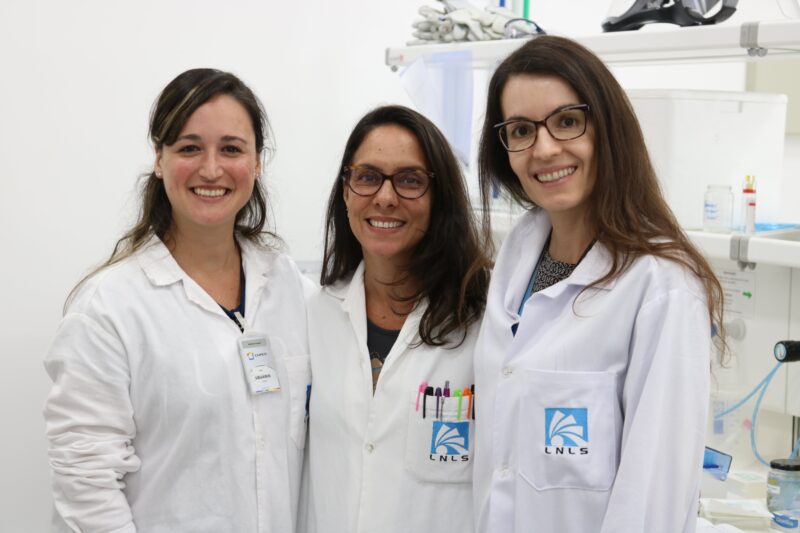
Study of the dynamics of prion protein aggregates by X-ray Photon Correlation Spectroscopy (XPCS) at the Cateretê beamline of Sirius
Brazilian researchers use Sirius facilities to investigate biophysical processes related to prions
Research published in the journal Science Advances by Brazilian researchers at the Federal University of Rio de Janeiro (UFRJ) used the Cateretê beamline at Sirius to investigate the biophysical mechanisms that cause the aggregation of proteins known as prions.
Diseases caused by prions (transmittable spongiform encephalopathies) are a group of neurodegenerative illnesses with long incubation periods that affect humans and other animals. The best-known examples include Creutzfeldt-Jakob disease and bovine spongiform encephalopathy (BSE), more popularly known as mad cow disease.
Although they are rare, these illnesses are progressive, always fatal, and currently untreatable. They are the only transmissible diseases known to be caused by proteins, and affect mammals.
“These proteins are present in various tissues in our bodies, but especially in the central nervous system. […] Their physiological function is still not clearly defined, but they bind to metals such as copper, which suggests that they could work as buffering agents and protect our cells from oxidative processes,” notes Yraima Cordeiro, a professor at the UFRJ School of Pharmacy and one of the coauthors of the article.
Normal prion proteins are described in the literature as PrPC and do not cause problems for the human body. But when their structure is altered and they become misfolded, they are known as PrPSC and become infectious agents capable of binding to the normal protein and converting it into the new misfolded shape. This chain reaction ultimately causes significant and inevitably fatal neurological damage.
Prion diseases can be sporadic, inherited, or acquired. The sporadic form is most common in humans, and is believed to occur due to an error in cell processes that spontaneously converts PrPC into PrPSC. The inherited type results from mutations in the genes that code for PrPC that make it vulnerable to structural alterations; the diseases caused by such mutations include fatal familial insomnia and genetic Creutzfeldt-Jakob disease.
Because misfolded prions can bind to normal proteins and convert them, some of these encephalopathies are transmissible, such as mad cow disease, which can affect bovines or humans that ingest meat contaminated with infected tissue (such as meat or bone meals).
This mechanism known as catalytic self-replication was described in significant studies using animals that do not produce prion proteins. “Mice or cows that do not produce prions were seen to be resistant to infection by misfolded prions, corroborating the hypothesis that this was the mechanism behind transmission of prion disease,” says Cordeiro.
The first case of mad cow disease was diagnosed in 1986 in the United Kingdom. The symptoms that manifest in cattle are difficulty walking, abnormal posture, weight loss, behavior changes, tremors, and hypersensitivity to external stimuli.
The BSE epidemic that occurred in the 1980s is believed to have been caused by how the cattle were fed. Their diet included meat and bone meal, which included tissues containing high concentrations of prion proteins that may have come from sheep infected with scrapie (a type of encephalopathy common in this species) or other bovines that developed the sporadic form of the disease.
Some years later in the 1990s, BSE appeared in humans and was known as variant Creutzfeldt-Jakob disease (vCJD). Over 200 cases were reported, most in the United Kingdom. Since that time, various countries have implemented rigorous import rules to limit infection, including Brazil.
These diseases are diagnosed based on clinical signs that only appear after long incubation periods. Currently, spongiform encephalopathy can only be confirmed in an autopsy.
Studies in the area have explored the role of copper ions in the origin and development of these conditions. As lead author of the article Mariana Juliani do Amaral notes, “[…] copper ions are very much present in the synaptic cleft, which is the region where neurons communicate with each other, and are never free. They could unleash chemical reactions that generate reactive oxygen species that react with all biological molecules including lipids, proteins, and even DNA, and can cause mutations or protein aggregation. […] oxygen reactive species are a common denominator in all neurodegenerative diseases. So this work focuses on the prion protein, but also considers something present in other diseases.”

Study of the dynamics of prion protein aggregates by X-ray Photon Correlation Spectroscopy (XPCS) at the Cateretê beamline of Sirius
The study used advanced analysis techniques such as X-ray photon correlation spectroscopy (XPCS) in the Cateretê beamline at Sirius to investigate the dynamics of intracellular condensates formed by the prion proteins. As highlighted by Aline Ribeiro Passos, a CNPEM researcher and coauthor of the article, conventional characterization techniques offer information about the whole, but the researchers were looking for data on these intracellular condensates, and the coherence of the beam generated by Sirius makes it possible to study these dynamics at the micrometer scale and provides quantitative information about the condensed phase and the liquid or gel form of protein droplets.

Researchers Mariana Juliani do Amaral (UFRJ), Yraima Cordeiro (UFRJ) e Aline Ribeiro Passos (CNPEM)
The research was carried out in conjunction with several researchers including professor Susanne Wegmann of the German Center for Neurodegenerative Diseases (DZNE), who is part of a group that focuses on describing processes of phase separation in these circumstances.
The prion proteins formed liquid-like droplets in their condensed form, which may reach extremely high concentrations up to 100 times greater than the surrounding environment. These discoveries are seen as an important landmark in understanding the interactions between prion proteins and copper ions and raise the possibility that these droplets could evolve into more stable aggregates over time, contributing to cell damage and progression of neurodegenerative diseases.
“This is an extremely promising area because it offers new opportunities for treatment. We did not know that there was this intermediary between the soluble and aggregated protein forms. And these liquid droplets could be good pharmacological targets, since the aggregated form is not. If we are able to keep these droplets in liquid form, we may be able to impede the progression of these neurodegenerative diseases,” adds Marina Juliani do Amaral.
A sophisticated and effervescent environment for research and development, unique in Brazil and present in few scientific centers in the world, the Brazilian Center for Research in Energy and Materials (CNPEM) is a private non-profit organization, under the supervision of the Ministry of Science, Technology and Innovation (MCTI). The Center operates four National Laboratories and is the birthplace of the most complex project in Brazilian science – Sirius – one of the most advanced synchrotron light sources in the world. CNPEM brings together highly specialized multi-thematic teams, globally competitive laboratory infrastructures open to the scientific community, strategic lines of investigation, innovative projects in partnership with the productive sector and training of researchers and students. The Center is an environment driven by the search for solutions with impact in the areas of Health, Energy and Renewable Materials, Agro-environment, and Quantum Technologies. As of 2022, with the support of the Ministry of Education (MEC), CNPEM expanded its activities with the opening of the Ilum School of Science. The interdisciplinary higher course in Science, Technology and Innovation adopts innovative proposals with the aim of offering excellent, free, full-time training with immersion in the CNPEM research environment. Through the CNPEM 360 Platform, it is possible to explore, in a virtual and immersive way, the main environments and activities of the Center, visit: https://pages.cnpem.br/cnpem360/.
Article published in Communications Materials presents significant findings and discusses the possibilities offered by this technique combined with synchrotron light sources
The research used diamond anvil cells (DAC) together with synchrotron light to investigate superconductors under extreme pressures